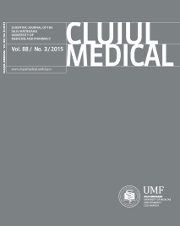Optimization of the sonication process for meloxicam nanocrystals preparation
DOI:
https://doi.org/10.15386/cjmed-445Keywords:
nanocrystals, nanosuspensions, meloxicam, high dissolution, design of experiments.Abstract
Background and aims. Meloxicam, a widely recommended AINS, presents poor water solubility, which limits its bioavailability and effect onset. The objective of this study is the investigation of the most important factors that influence the efficiency of sonication in the preparation of meloxicam nanocrystals.
Methods. The effects of crucial technological sonication parameters (amplitude, time and applied cycle) on the crystal sizes and dissolution were investigated using a central composite experimental design with three factors and three levels. Different mathematical models were applied for the evaluation of the influence of each factor on the measured responses.
Results. The amplitude and the time were found as the most important variables. Their increase determined significant size reduction and homogeneity due to cavitation phenomenon, while the applied cycle was less important. The crystal size greatly influenced dissolution; a strong correlation was noted between small crystals and fast dissolution after freeze-drying the nanosuspensions. The optimal formulation was obtained by sonication at 100% amplitude, for 45 minutes and cycle 1, conditions which led to 600 nm crystals with 0.521 polydispersion index. The morphological analysis revealed small, round-shaped crystals with narrow size distribution.
Conclusions. The results provided the optimal sonication conditions needed to obtain meloxicam nanosuspensions with high drug dissolution capacity.
Downloads
Additional Files
Published
How to Cite
Issue
Section
License
The authors are required to transfer the copyright of the published paper to the journal. This is done by agreeing to sign the Copyright Assignment Form. Whenever the case, authors are also required to send permissions to reproduce material (such as illustrations) from the copyright holder.

The papers published in the journal are licensed under a Creative Commons Attribution-NonCommercial-NoDerivatives 4.0 International License.

